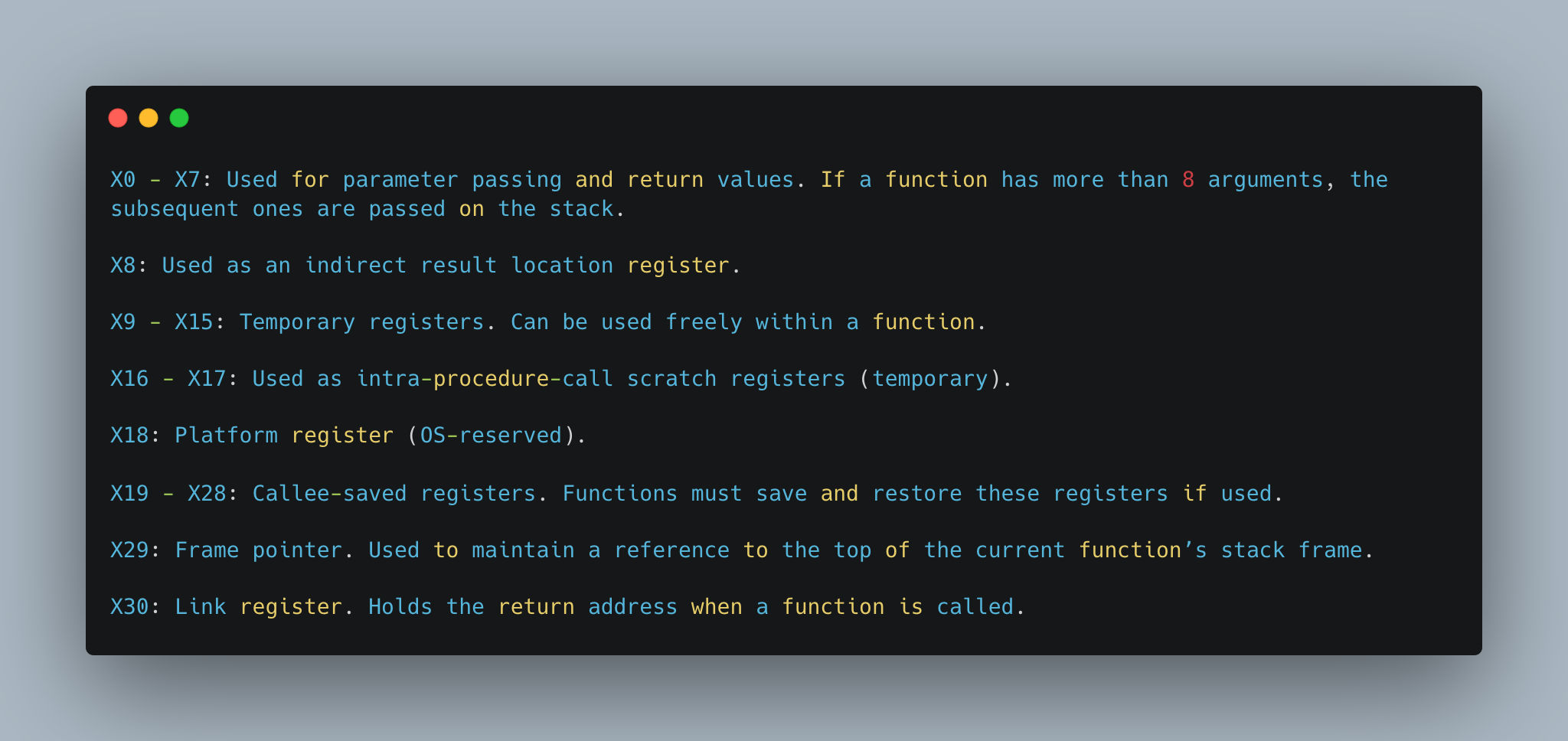ARM64 (MacOS) Calling Convention Cheat Sheet
ARM64, also known as AArch64, is the 64-bit execution state introduced in the ARMv8 architecture. If you’re diving into ARM64 assembly on macOS, understanding the calling convention is crucial. It helps in ensuring interoperability between function calls, making your code more readable, maintainable, and efficient. Here’s a cheat sheet for the standard ARM64 calling convention on macOS:
Table of contents
- General-Purpose Registers
- Floating Point and Vector Registers
- Stack
- Function Calling
- Function Return
- Variadic Functions
- System Calls
- Conclusion
General-Purpose Registers
There are 31 general-purpose registers, labeled X0 to X30. The 32nd register is the stack pointer, SP.
X0 - X7: Used for parameter passing and return values. If a function has more than 8 arguments, the subsequent ones are passed on the stack.
X8: Used as an indirect result location register.
X9 - X15: Temporary registers. Can be used freely within a function.
X16 - X17: Used as intra-procedure-call scratch registers (temporary).
X18: Platform register (OS-reserved).
X19 - X28: Callee-saved registers. Functions must save and restore these registers if used.
X29: Frame pointer. Used to maintain a reference to the top of the current function’s stack frame.
X30: Link register. Holds the return address when a function is called.
Floating Point and Vector Registers
There are 32 SIMD (Single Instruction, Multiple Data) and floating-point registers, labeled V0 to V31.
V0 - V7: Used for parameter passing and return values for floating-point and vector data.
V8 - V15: Must be saved and restored by the callee if used.
V16 - V31: Temporary registers.
Stack
The stack is full descending, meaning the stack grows down in memory.
SP: Stack Pointer. Always points to the top of the stack.
Stack alignment: Must be 16 bytes. Functions must maintain this alignment.
Function Calling
Arguments: First 8 integer or pointer arguments in
X0toX7. First 8 floating-point or vector arguments inV0toV7. Additional arguments are passed on the stack.Return values: Integer and pointer return values in
X0(andX1if needed). Floating-point or vector return values inV0(andV1if needed).Callee-saved registers:
X19toX30,V8toV15. Functions must restore these if they are used within the function.
Function Return
A function returns to its caller by branching to the address in X30 (the link register).
Variadic Functions
For functions with a variable number of arguments:
Named arguments are passed as usual.
Unnamed arguments are passed in registers until they are filled, then on the stack.
System Calls
Arguments:
X0toX7.System call number: In
X16.
Conclusion
When coding in ARM64 assembly on macOS or dealing with debugging and reverse engineering, understanding the calling convention can be invaluable. It helps in tracking the flow of data between functions, deciphering the purpose of various registers at different points in time, and making sense of the machine code in front of you.
